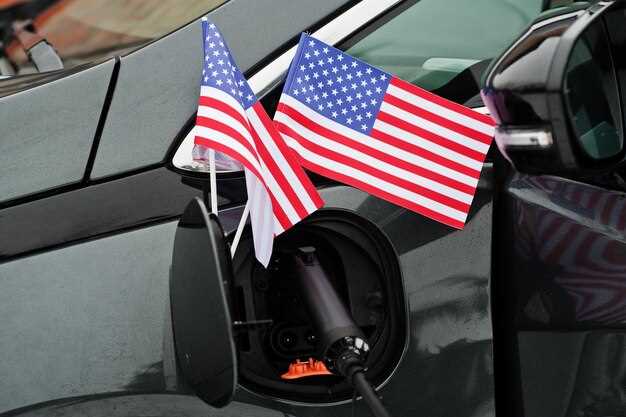Adopt a nationwide, performance-based framework that prioritizes safety and scale: this is the first step to establishing the largest, coherent regulatory horizon for autonomous vehicles. The goal is allowing efficient deployment while maintaining rigorous testing across sensors ja operation of fleets, so the ecosystem can feel confident about growth and operate efficiently.
Under a federal framework, regulators should define first principles and a clear process for approving sensors, sensor data, and vehicle control systems. This approach minimizes tensions between agencies and, where rules intersect, the framework navigates cross-state programs with clarity. A ripple effect follows: standardization invites suppliers to invest, as automakers can more efficiently operate across jurisdictions and deliver safer features to customers. Regulators will have predictable enforcement cadence to reduce surprises.
Since the early pilot programs, fleets have learned how autonomous operation adapts to lane changes, weather, and traffic patterns. By 2023, dozens of states supported coordinated testing while requiring transparency around data collected by sensors and safety drivers. Before a national baseline, companies faced duplicative filings and inconsistent safety criteria, which slowed deployment and impacting investment decisions.
Looking forward, the plan should include concrete milestones: first, second, third, fourth, codify safety performance metrics and a robust process for post-market updates; second, publish a common data standard for event reporting and sensor logs; third, launch a single federal permitting portal to replace duplicative filings; fourth, establish a semi-annual review to adjust requirements as technology and road use evolve. This framework is built for looking ahead to the next 3-5 years, helping policymakers track the largest cost drivers–hardware, software integration, and cyber resilience–and publish annual dashboards to guide investment decisions for automakers and suppliers alike, looking ahead to evolving road conditions and technology.
Ultimately, this horizon empowers the industry to navigate a broader market while policing high safety standards. By aligning incentives and clarifying expectations, regulators reduce ambiguities that have historically slowed progress since the earliest trials, enabling larger fleets, faster sensor updates, and more reliable weather conditions handling in daily operation. The result is a more stable ecosystem where customers feel confident and manufacturers have a clear path to scale.
20 Posts in 20 Days: The Trump Administration and Autonomous Vehicles

Begin a 20-day series that translates regulatory shifts into actionable steps for automakers, fleets, and road authorities. Each post delivers concrete takeaways you can implement within two weeks, keeping teams aligned and reporting clear.
-
Day 1 – Establish the baseline: map the administration’s announced actions, identify the responsible agencies, and assign a dedicated team to track daily changes that affect road tests and deployment. This clarity lets you serve stakeholders faster and accelerate the planning cycle, with a clear days-to-action target and documented reporting.
-
Day 2 – Safety testing and reporting: define a minimal set of safety metrics, such as disengagement rates, miles driven in test programs, and incident reporting timelines. These figures guide decisions, inform investors, and help avoid unnecessary delays that increase costs.
-
Day 3 – Security and data governance: outline data-flow controls, encryption requirements, and incident response workflows. A focused security plan reduces risk, speeds data sharing with partners, and protects personal information on roads and at testing sites. Include a quick checklist for within-pac training and breach drills.
-
Day 4 – Impact on automakers’ cost structure: break down compliance costs, testing expenses, and potential tax or incentive implications. A transparent cost map helps some teams prioritize investments in safer systems and prioritize additional hardware that improves braking and control reliability.
-
Day 5 – Personal mobility implications: analyze how regulatory signals shape consumer access to autonomous options, fleet pricing, and shared-ride models. Highlight areas where these shifts could alter ownership models and expand markets for mobility services.
-
Day 6 – Technology stack choices: compare sensor suites, software platforms, and simulation capabilities that align with policy expectations. Recommend an evaluation framework to accelerate vendor comparisons and avoid overcommitting to a single solution before testing in real conditions.
-
Day 7 – Roads and infrastructure readiness: map which corridors are prioritized for trials, noting congestion patterns and lane configurations. Provide a two-step plan for test routes: first, low-density segments that build data; second, busier arteries to measure performance under load.
-
Day 8 – York testing corridors: summarize findings from pilot programs in york-facing corridors, focusing on how local regulations interact with federal guidance. Reporters should track how these pilots influence overall deployment timelines and private investment decisions.
-
Day 9 – Local and state collaboration: identify which areas require joint permits, data-sharing agreements, and public-communication plans. A clear cross-jurisdiction process reduces delays and builds public trust in automated safety features.
-
Day 10 – Market outlook and investment signals: assess how national policy shifts affect venture funding, supplier ecosystems, and entry costs for new platforms. Provide a practical forecast and a 90-day action plan for teams seeking partners in new markets.
-
Day 11 – Fleet deployment strategies: offer a 4-step approach for operators to scale from pilot to commercial use, including route selection, readiness reviews, driver-operator training, and a phased braking-system validation schedule that reduces risk and speeds deployment.
-
Day 12 – Security posture in practice: present a real-world tabletop exercise showing how cyber threats could disrupt vehicle controls and vehicle-to-infrastructure communication. Conclude with a 2-page incident-response playbook for the team to follow during an alert.
-
Day 13 – Data rights and transparency: propose a user-friendly disclosure framework that explains how data is collected, stored, and used. Include a consent model for personal data and a short, plain-language notice for customers and regulators alike.
-
Day 14 – Global competitiveness and markets: compare U.S. policy signals with peer markets, highlighting where the administration’s approach could hinder or accelerate U.S. industry leadership. Offer a risk-reduction plan for automakers entering international collaborations.
-
Day 15 – Small businesses and suppliers: outline funding opportunities, joint-development programs, and streamlined procurement paths that bring new tech into the supply chain. Include a two-week sprint for onboarding vendors and validating compatibility with legacy systems.
-
Day 16 – Operator training and human factors: define training modules for drivers in semi-autonomous contexts and specify how to evaluate fatigue, attention, and interaction with automated systems. A practical schedule of micro-lessons improves safety and trust in technology.
-
Day 17 – Step-by-step fleet integration: provide a practical checklist to bring a fleet from test to commercial service, including route optimization, maintenance plans, and brake-system validation for edge cases that occur in dense traffic.
-
Day 18 – Emergency response and incident flow: map the response chain for on-road events, outlining cooperation with police, EMS, and traffic management centers. Clarify reporting timelines and data-sharing boundaries to minimize disruption and protect security.
-
Day 19 – Sunset clauses and policy horizon: evaluate potential sunset provisions or renewal triggers, and recommend how to design pilot programs to yield decision-ready data within 18–24 months. Include a risk register for policy shifts that may affect ongoing deployments.
-
Day 20 – Synthesis and next steps: compile the 20-day learnings into a concise action playbook for automakers, fleets, and policymakers. Deliver a prioritized list of 8 recommendations that accelerate adoption, reduce congestion around deployments, and strengthen roads with reliable technology and strong controls.
Regulatory Milestones Timeline: Key AV Rules by Year

Prioritize aligning state pilot programs with federal safety standards to speed deployment while protecting consumers.
| Vuosi | Virstanpylväs | Provisions / Focus | Vaikutus |
|---|---|---|---|
| 2016 | NHTSA AV Safety Principles Released | Establishes voluntary framework for testing, data transparency, privacy protections; encourages manufacturers to publish safety assumptions and crash data; sets baseline for accountability. | Set initial benchmarks; reach across states; tensions emerge between federal guidance and state autonomy. |
| 2017 | Interagency Committee Formed for Coordination | Creates a centre of excellence to explore the idea of harmonized definitions, risk assessment, and cyber security; to continue cross-agency collaboration. | Provides a shared forum to test ideas and align standards, reducing friction between agencies. |
| 2018 | State Pilot Programs Authorized | States expand pilot programs; chinese automakers and US OEMs tested on-road; regulators collect data on interaction with pedestrians and passengers; emphasizes ongoing research. | Lessons inform safety criteria and consumer-facing expectations; deployment begins to reach cities and suburbs, though infrastructure challenges persist. |
| 2019 | Streamlined Permitting for Testing | Trump administration introduced a streamlined permit approach, cutting duplicative approvals; promotes faster test cycles; supports cross-border collaborations with standards bodies. | Faster test cycles; creates space for real-world feedback; tensions with some state regulators over oversight persist. |
| 2020 | Safety and Security Guidelines Emphasized | Guidelines require crash reporting, cyber security measures, data retention; establishes a data store for de-identified incident data; encourages supporting research with universities. | Improved incident visibility; regulators can identify patterns; challenges include privacy concerns and vendor data formats. |
| 2021 | ADS Rulemaking Initiated | NHTSA opens rulemaking to define ADS performance, monitoring, recall processes; invites industry input through public workshops; explores testing frameworks to continue safety improvements. | Regulators balance safety with innovation; feedback loops accelerate improvements; researchers continue to explore new ideas. |
| 2022 | Harmonization Efforts Intensify | U.S. agencies align with international norms; a cross-border committee explores common data schemas; focus on consumer-facing safety ratings and accountability. | Consumers gain clearer expectations; deployments expand; chinese suppliers and peers push for standardization. |
| 2023 | Liability and Data Sharing Frameworks | New guidelines clarify liability in mixed-traffic scenarios; establish data sharing requirements for incident investigations; creates a voluntary registry for safety outcomes. | Clarity supports planning; data sharing builds trust; consumers expect transparency about data stores and storage practices. |
| 2024 | Beyond the Trump Framework | Policy continues to evolve; aims to create a unified federal-state approach; encourages ongoing research; outlines pilot-to-production pathways to deploy at scale. | Scale remains a challenge; focus on consumer feel and governance; continuous improvement to data governance beyond earlier rules. |
Data and Privacy Obligations for AV Testing and Deployment
Adopt privacy-by-design across all AV testing and deployment phases, starting with data minimization and explicit consent for personal data collection, and set clear retention limits aligned with testing objectives. Map data flows to identify where personal data travels, who touches it, and how it is used in each activity, using robust technology to protect sensitive information.
Establish a governance model with clear roles and accountable owners for data stewardship in each market, including california, with direct responsibilities for privacy, security, and compliance. Build an integration-ready framework that supports safe data sharing with partners and service providers, while allowing control over access and usage.
Define data-sharing and localization commitments: use data-sharing agreements with ford and other OEMs for testing, specify where data can be stored, and require encryption at rest and in transit, plus de-identification for analytics. Document data lineage to track how personal data moves through the system.
Require privacy impact assessments for every new testing activity and deployment update; constantly monitor for implications, especially when expanding to new california markets or additional fleet partners, to deliver more consistent privacy protection and meet expected safety outcomes. Align with established rulemaking signals while ensuring governance keeps inconsistent data practices from creeping into operations.
Enforce direct control of steering and service interfaces: only authorized teams may access sensor and telematics data, restricting personal data usage to what is strictly necessary for safety validation; this approach keeps operations safely on track and supports more reliable updates in real-world conditions.
Create practical metrics: percentage of data redacted, time-to-respond to privacy incidents, and number of approved data uses per market; use these to guide where to expand markets and improve solutions while keeping users safe.
Federal vs State Roles: Navigating Reg Oversight on Public Roads
Recommendation: Establish a federal safety baseline for autonomous vehicles and empower state regulators to tailor on-road approvals through autonomous-friendly licensing. This yields similar safety expectations for vehicles on public roads and keeps wheel-level interactions predictable. The baseline should trace back to a clear function from safety goals: protect the public while enabling deployment models that scale. The published framework must be transparent, with lawmakers informed and school-based training generally aligned with industry needs.
Roles and responsibilities: The federal layer sets baseline safety, cybersecurity, testing, and data-sharing requirements; states handle operational licensing, local testing corridors, and risk-based restrictions for traffic integration. A phased approach allows proposed pilot programs and the elimination of duplicate rules; regulators publish status updates regularly to keep stakeholders informed. The framework should be generally consistent in jurisdictions, with a clear pathway for providers to scale operations and share safety alerts and disposition data.
Implementation steps: Publish the federal baseline; require state adoption within a defined timeline; build a single compliance ecosystem that reduces redundant rules. Invest in school and industry training to prepare the workforce for AV operations, while ensuring that data-sharing and periodic reviews are built into the program. Regulators should publish metrics on safety, uptime, and incident disposition, and lawmakers should reflect on elimination of unnecessary rules in annual updates.
Liability and Insurance Shifts under the New Regulatory Horizon
Adopt a fault-based liability model tied to the automated driving system layer and require modular, deployment-stage insurance coverage. This choice reduces litigation time and aligns incentives for manufacturers, fleets, and riders, enabling gains in deployment speed to achieve faster outcomes. The approach is likely to streamline claims handling and shorten dispute cycles.
Liability should follow a clear classification of automation features. If the vehicle operates in a mode similar to human driving, fault may be shared; when the fault stems from vendor-supplied software, the vendor’s role increases. This clarity makes settlements quicker and helps operators control costs, making coverage less costly for small fleets and startups.
California sets baseline expectations that tie insurance requirements to deployment tiers and safety milestones. In california and across the north region, regulators should align minimum coverage, data-sharing guidelines, and dispute-resolution standards to support business growth. For least-risk operators, terms should be favorable, while more complex fleets receive tailored policies. The deployment year will anchor pricing bands and responsibility allocation.
Insurers shift toward data-driven pricing, leveraging telematics, incident records, and standardized classification to tailor policies. This yields gains in risk discrimination and reduces premiums for compliant operators. Guidelines will support shared data interfaces and policy parameters that help smaller players improve accessibility to coverage. This shift removed coverage gaps that appeared when data access was limited and continues to expand the market. This shift requires alignment across markets and stakeholders to sustain momentum.
Justyna emphasizes that ongoing dialogue among manufacturers, insurers, and policymakers is required to maintain a stable path for liability and insurance as regulation evolves. Clear guidelines, a straightforward classification framework, and practical data standards and enforcement practices are in place to support progress this year and beyond.
Safety Assurance: Testing Protocols, Crash Reporting, and Audits
Adopt a centralized Safety Assurance framework that standardizes Testing Protocols, mandates Crash Reporting, and requires independent Audits across the country’s automated vehicle programs. Start with a direct, risk-based pass criterion, tie testing outcomes to roadway operations, and publish findings within 30 days to regulators and the public. This approach reduces uncertainty and supports industry-wide consistency.
Testing Protocols should combine closed-course exercises with on-road trials within controlled roadway corridors, supported by high-fidelity simulations. Design scenarios based on exposure metrics, incident history, and worst-case conditions to test controls under real-world stress. Require independent verification, blind data reviews, and regular updates to the regulatory baselines as developing technologies shift the risk profile; currently, the most challenging cases receive scrutiny.
Crash Reporting must use a standardized data schema, immediate notification for significant events, and cross-agency sharing. Require reporting to national and state regulators, with anonymized datasets for external audits. Return dashboards that summarize crash frequencies, contributing factors, and intervention effectiveness; implement cross-border reporting across states to reveal trends impacting roadway safety and regulatory compliance.
Audits should occur on an annual basis with independent firms that assess testing logs, safety controls, software version histories, and data integrity. Actions from audits require corrective tasks with clear owners and timelines; track progress and publicly disclose remediation outcomes. Use audit findings to recalibrate regulations and testing baselines, ensuring that controls keep pace with automated capabilities and operator responsibilities.
Within michigan programs, these practices create a predictable safety standard that regulators assume will be followed by operators, suppliers, and manufacturers. The justyna-led team at ford demonstrates how these elements translate into actionable improvements, feeding an initiative that is bigger than one company and currently shaping how programs operate across the country. justyna provides field data, and regulators assume data shared by operators remains accurate. When audits confirm compliance, the country gains a clearer picture of safety gains. Income for compliant vendors stabilizes through consistent pass criteria while regulatory oversight grows more transparent. These working groups, focused on roadway safety, can adapt quickly as demand shifts and new automated functions roll out, ensuring the country maintains a practical, measurable safety edge.

 The Trump Administration’s Impact on Autonomous Vehicles – A New Regulatory Horizon">
The Trump Administration’s Impact on Autonomous Vehicles – A New Regulatory Horizon">
